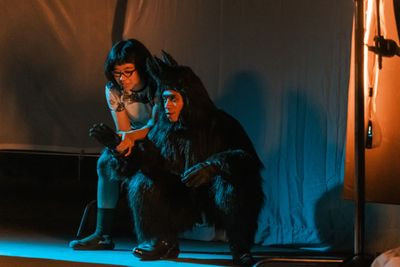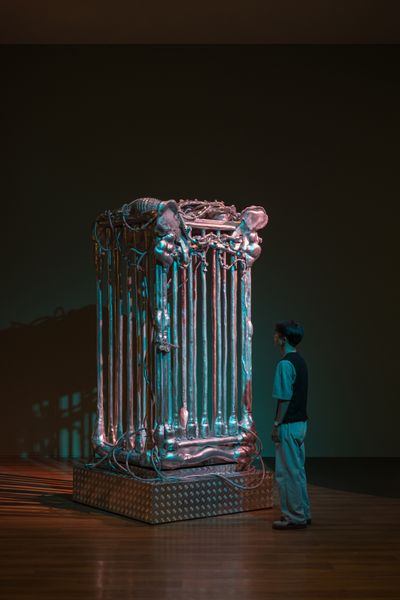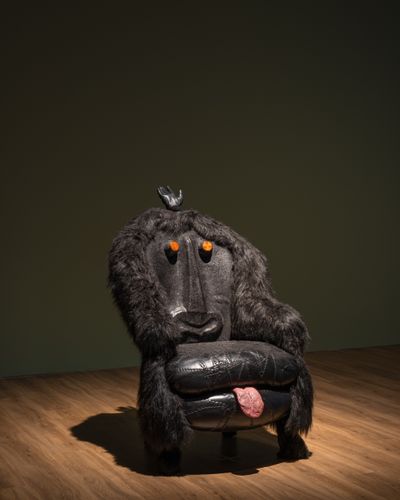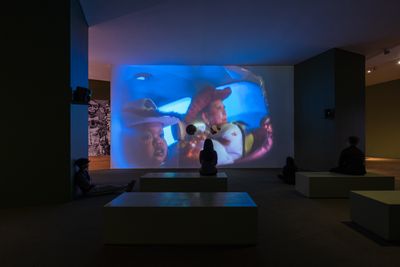
29 Nov Natasha Tontey’s B Movie Monkey Business
Source Credit: Content and images from Ocula Magazine. Read the original article - https://ocula.com/magazine/art-news/natasha-tonteys-b-movie-monkey-business/
At Jakarta‘s Museum MACAN, Tontey takes audiences on a fantastical journey, enlisting black-crested macaques in a kind of interspecies peace negotiation.

Natasha Tontey. Exhibition view: Primate Visions: Macaque Macabre, commissioned by Audemars Piguet Contemporary, Museum MACAN, Jakarta (16 November 2024–6 April 2025). Courtesy the artist and Audemars Piguet.
Natasha Tontey was born in 1989 on the Minahasan Peninsula in the North Sulawesi province of Indonesia. Though she’s now based in Jakarta and Yogyakarta, her Minahasan ancestry—along with a love of John Waters films and an interest in Spaghetti Westerns—informs the phantasmagorical exhibition Primate Visions: Macaque Macabre (16 November 2024 to 6 April 2025) at Museum MACAN.
Tontey’s first institutional solo show is an immersive video installation, commissioned by Audemars Piguet Contemporary, that incorporates outlandish costumes and sets in an exploration of the relationship between the indigenous people of South Minahasa and black-crested macaques, or yaki. In the film, an experimental primatologist and their team liberate a troop of yaki held captive in a forest. Following their release, they engage in dialogue, conduct experiments, and imagine the future relationship between humans and yaki, exploring both connections and misunderstandings.
The exhibition builds on previous works such as Garden Amidst the Flame (2022), The Epoch of Mapalucene (2021), and Of Other Tomorrows Never Known (2023) that draw on Minahasan cosmology to challenge anthropocentric attitudes. Minahasans believe their ancestors were born from stone, which Tontey points out supports moss, which nourishes other life forms in a chain of interactions that ultimately sustains human beings.
Exhibition view: Natasha Tontey, Primate Visions: Macaque Macabre, commissioned by Audemars Piguet Contemporary, Museum MACAN, Jakarta (16 November 2024–6 April 2025). Courtesy the artist and Audemars Piguet.
Can you share a bit more about your experiences with yaki and Mawolay, a Minahasan ritual in which locals wear monkey-like costumes to deter the monkeys from raiding their villages?
In Minahasa, and particularly in Po’opo [in southern Minahasa], the yaki is perceived in two contrasting ways by the indigenous community. On the one hand, it represents a more-than-human connection, seen as an integral part of the local social structure. On the other, it is regarded as a pest that raids villagers’ crops. This duality reflects a long-standing coexistence fraught with challenges. In recent years, Western NGOs have entered the village to promote biodiversity conservation and raise awareness about the yaki‘s endangered status. However, this has created tension, as these organisations often lack a nuanced understanding of the historical and structural factors shaping the indigenous people’s relationship with the yaki.
For the villagers, the root of the issue lies in deforestation and land exploitation—such as mining—which have depleted the yaki‘s natural food sources, forcing them into the villages in search of sustenance. Simultaneously, this environmental degradation has also diminished the resources available to the indigenous people, many of whom still rely on hunting for survival. Consequently, the yaki becomes both a competitor and a food source, illustrating the deeply entangled struggles of conservation, survival, and human-animal relationships.
Interestingly, the relationship between humans and yaki also reflects a peculiar similarity: both are primates with a tendency to steal. While yaki often take crops from villagers, humans have, in a broader sense, ‘stolen’ the yaki‘s habitat through deforestation and land exploitation.
The Mawolay ritual, in which villagers dress as yaki and perform processions through the region, serves as a form of mediation between these conflicting perspectives. It represents an attempt to address the tension between humans and the yaki without resorting to violence against nature. This ritualistic performance, rooted in trance-like states where humans embody macaques, offers a symbolic resolution to the conflict, blending artistic practice with ecological and social concerns. The transformative act of ‘becoming yaki‘ blurs the boundaries between evolution and devolution, whilst the presence of yaki as both a symbolic costume and a literal dish highlights the complex and often contradictory dimensions of coexistence.
Exhibition view: Natasha Tontey, Primate Visions: Macaque Macabre, commissioned by Audemars Piguet Contemporary, Museum MACAN, Jakarta (16 November 2024–6 April 2025). Courtesy the artist and Audemars Piguet.
You’ve drawn on the ideas of Donna Haraway, author of Primate Visions (1990), in which she argues that scientific observations are coloured by gender, with male primatologists, for instance, focusing on physical competition and reproduction, whereas female primatologists might foreground communication and survival strategies. In what ways is Primate Visions: Macaque Macabre a feminist work?
Whilst borrowing its title from Donna Haraway’s seminal work, my work extends beyond her critique of gendered scientific observation into a realm that deliberately leans less on science and more on fiction. Influenced by Terence McKenna’s stoned ape theory from Food of the Gods (1992), and my earlier work Pest to Power (2019), this project examines resilience, adaptability, and ecological interdependence. The yaki‘s behaviours, particularly the ecological wisdom exhibited by female macaques, serve as a lens through which to examine broader questions of survival, sustainability, and coexistence.
Despite being led by males, yaki groups depend on the high degree of social tolerance exhibited by females. These females not only stabilise their groups but also regulate fruit consumption, ensuring resources are not exhausted—a behaviour primatologists term ‘social tolerance’. This ecological intelligence parallels the sustainability practices of Minahasan women, who often act as caregivers and mediators within their communities. In the work, this parallel is explored through performance: two male Minahasan actors portray yaki, while three female actors embody human characters who, like female yaki, strive to restore balance in an increasingly alienated world.
This deliberate inversion—where human women adopt the behaviours of female yaki—challenges patriarchal narratives that prioritise domination over care and exploitation over collaboration. It aligns with Ecofeminism’s critique of hierarchical systems, advocating instead for mutual respect and interdependence between humans and the environment.
Exhibition view: Natasha Tontey, Primate Visions: Macaque Macabre, commissioned by Audemars Piguet Contemporary, Museum MACAN, Jakarta (16 November 2024–6 April 2025). Courtesy the artist and Audemars Piguet.
The exhibition incorporates props and practical effects reminiscent of those found in B movies (recently resurgent in films like MAXXXINE and The Substance), including a cowboy hat made of human hair, a monkey-faced armchair, and quilts that resemble pink flesh or monkey buttocks. Why were you interested in this aesthetic?
I’ve always been fascinated by the aesthetic of B movies, particularly their resourceful, camp charm and their ability to blend humour, horror, and fantasy. I’m a fan of filmmakers like John Waters and Sun Ra, as well as Indonesia’s 1980s and ’90s horror soap operas and the legendary Indonesian ‘Horror Queen’, Suzzanna. These influences shape the fantastical and irreverent aesthetic of my exhibition, which seeks to combine the grotesque, the absurd, and the deeply speculative.
The exhibition invites the audience on a conceptual journey through the body of an evolving yaki, entering through its buttocks—a notion rooted in the digestive system but reimagined as a gateway to knowledge. The anus is typically regarded as an endpoint, but I wanted to reverse that perspective. What if the audience becomes the source of knowledge for this yaki as it transforms, absorbing ideas and experiences from its human visitors?
I find it particularly intriguing how Western pop culture—such as country music, cowboy hats, and Spaghetti Westerns—has been hegemonised and consumed globally, including by indigenous communities in Tondano especially, and how it becomes distorted and reappropriated into something entirely new. This syncretic blending, shaped by the histories of capitalism and colonialism in the region, creates a cultural landscape where everything is interconnected and open to reinterpretation.
Exhibition view: Natasha Tontey, Primate Visions: Macaque Macabre, commissioned by Audemars Piguet Contemporary, Museum MACAN, Jakarta (16 November 2024–6 April 2025). Courtesy the artist and Audemars Piguet.
Having brought Primate Visions: Macaque Macabre into being, what do you want to do next?
Looking ahead, I am trying a more personal journey by working with my father on a new project. My father’s long-lost history, shaped by his psychedelic approach to religion, his time stranded at sea swimming with dolphins, and his relationship with hypermasculinity, has become a focal point. This project seeks to uncover the layered narratives of his life while also challenging dominant ideas of masculinity in Minahasan culture.
I am also pursuing research into the marginalised Minahasan people who, after the Permesta War (1957–1961), formed gangs named Sartana and bodybuilding clubs in the 1950s—a fascinating intersection of resistance, camaraderie, and hypermasculine performance. Working with my father and exploring these histories presents new challenges, particularly emotional ones. —[O]
Source Credit: Content and images from Ocula Magazine. Read the original article - https://ocula.com/magazine/art-news/natasha-tonteys-b-movie-monkey-business/





